Kaiseki 懐石
Kaiseki is a traditional Japanese dining experience that embodies the essence of seasonal and meticulously prepared dishes. It is a multi-course meal that follows a specific sequence and showcases the harmony of flavors, textures, and presentation. Each dish is carefully crafted using fresh, locally sourced ingredients to highlight their natural flavors.
Kaiseki typically consists of several courses, including appetizers, sashimi, simmered dishes, grilled dishes, and a final course of rice or noodles. The chef's skill and attention to detail are evident in every aspect, from the arrangement of the dishes to the choice of tableware.
The aim of kaiseki is to create a balanced and unforgettable dining experience that reflects the season and evokes a sense of tranquility. It celebrates the beauty of simplicity, incorporating elements of Japanese aesthetics, such as minimalism and harmony. Kaiseki is not just a meal but a cultural expression that showcases the rich culinary heritage of Japan.
Styles
Kaiseki cuisine is primarily divided into two dining styles: "Kappo" and "Ryotei." In the case of "Ryotei," the dishes are typically served in a specific order, from front to back and left to right.
The most authentic way to enjoy Kaiseki cuisine is by holding the small dish in the palm of your hand, using chopsticks to eat, and returning it to its original place. When indulging in Kaiseki cuisine, it is essential to adopt a mindset of contentment and harmonious coexistence with nature, which closely aligns with the spirit of Zen.
If you have seen the television drama "Hanzawa Naoki," you may be familiar with the scenes set in "Ryotei," known for its privacy and exclusivity, catering to established clientele and discreet political and business figures.
The mention of an 11-course meal in Kaiseki cuisine can intimidate many, but fear not. Kaiseki cuisine emphasizes the absence of leftovers, hence each dish is designed to be a small portion that can be enjoyed in one bite without bones or fish bones.
Moreover, temperature plays a critical role. Cooked dishes are served warm but not hot, allowing for a delicate balance of flavors - sour, sweet, bitter, spicy, salty, and umami. It truly provides a perfect dining experience.
Courses
[Course 1: Sakizuke 先付] After your drink is served, the first course, known as "Sakizuke," is presented. It is equivalent to the "otoshi" or "tsukidashi" in Japanese restaurants. Sakizuke varies in uniqueness, utilizing seasonal ingredients or offering delicacies, depending on the establishment.
[Course 2: Oshinogi お凌ぎ] To prevent getting drunk or experiencing hunger pangs after consuming beer on an empty stomach, the "Oshinogi" course is served. It includes bite-sized sushi, nigiri sushi, and small portions of soba or udon noodles, among others.
[Course 3: Owan お椀] The "Owan" course is served to cleanse the palate and rinse the mouth. Although subtly presented, it is an important dish where the skills of the chef can be appreciated through the preparation of the broth, arrangement, taste, and aroma. It is customary to first sip a small amount of the soup before enjoying the ingredients.
[Course 4: Mukozuke 向付] "Mukozuke" refers to seasonal sashimi, using fresh fish. It involves intricate techniques such as knife cuts and marinating in kombu, enhancing the flavors.
[Course 5: Hassun 八寸] "Hassun" is a dish featuring a combination of seasonal ingredients from land and sea. It signifies that you can enjoy your drink until the next course.
[Course 6: Yakimono 焼き物] "Yakimono" consists of grilled fish using seasonal varieties, often decorated with maple leaves or pine. Its visual appeal adds to the dish's charm. Some establishments also offer grilled meat dishes.
[Course 7: Takimono 炊き合わせ] "Takimono" refers to simmered dishes made with seasonal vegetables and other ingredients. For dishes with abundant broth, it is customary to enjoy the ingredients along with the broth.
[Course 8: Rice ご飯] The style of rice preparation, such as "takikomi gohan" (rice cooked with various ingredients) or small rice bowls, varies among different establishments. Accompanying the rice are red miso soup and pickles.
[Course 9: Mizugashi 水菓子] "Mizugashi" is a refreshing course that cleanses the palate, often consisting of seasonal fruits, ice cream, sorbet, and other sweet treats.
While there may be slight variations between establishments, understanding these names and their order will enhance your dining experience as you appreciate the presentation of the dishes and their flavors. I hope this provides further insights into the intricacies of Kaiseki cuisine.
kaiseki ryori(懐石料理) vs kaizeki ryori(会席料理)
Nimono Wan course(煮物椀)
"Kaiseki cuisine" is for enjoying tea, while "Kaizeki cuisine" is for enjoying sake. The most significant difference between "Kaiseki cuisine" and "Kaizeki cuisine" is evident in the Nimono Wan course(煮物椀).
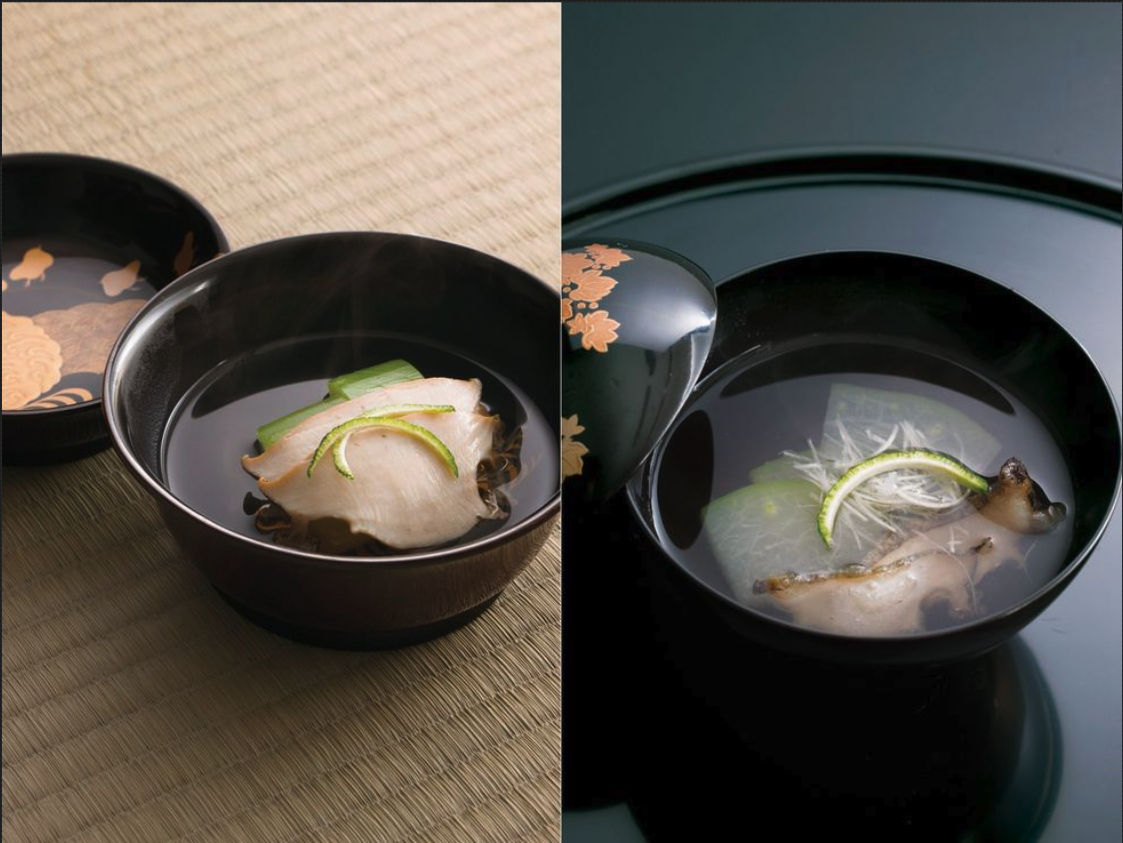
On the left is a Nimono Wan dish from Kaiseki cuisine, featuring steamed abalone and winter melon. On the right is a crystal-style Nimono Wan dish from Kaizeki cuisine, showcasing winter melon and abalone.
In modern times, Kaiseki cuisine is served during tea ceremonies, while Kaizeki cuisine is enjoyed with sake at restaurant banquets. The distinct difference between the two is exemplified by the Nimono Wan course. In Kaiseki cuisine, the dish serves both as a simmered dish and a soup, generously filled with ingredients to satisfy the appetite before drinking tea. Therefore, in Kaiseki cuisine, it is served in a larger bowl with ample portions of abalone and winter melon, following the Gohan (rice), Shiru (soup), and Mukozuke courses. On the other hand, Kaizeki cuisine features a more modest presentation of the Nimono Wan dish. It focuses on savoring the essence of the broth and avoids burdening the stomach when consuming sake. The dish is prepared to highlight the broth itself, with a subtle presence of abalone visible within the soup. It is served after the Sakizuke course.
Sashimi(向付vsお造り)
Even with the same fish sashimi, the naming and presentation can differ.
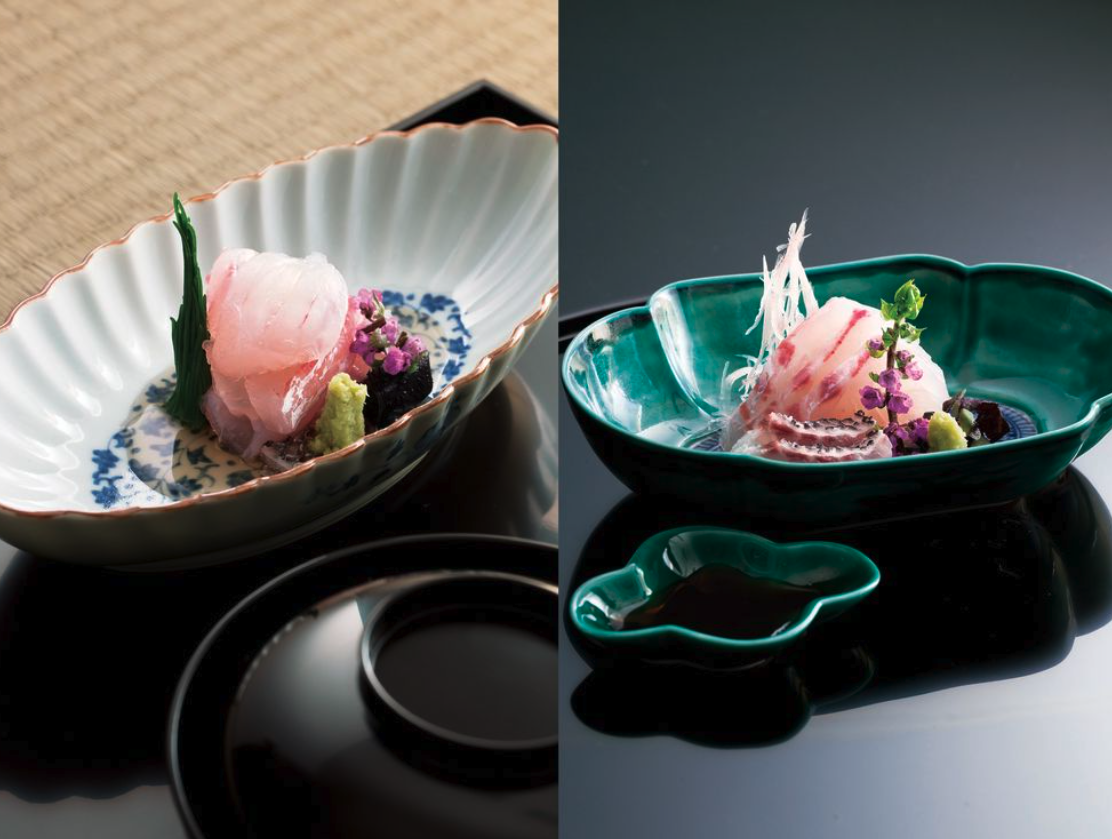
On the left is Mukozuke (向付) in Kaiseki cuisine. It gets its name from being placed beyond the rice and soup. On the right is Otsukuri (お造り) in Kaizeki cuisine. It is often presented as Hirazukuri(平造り), a style of flat arrangement that highlights the beauty of the angles.
During the Momoyama(桃山) period, until the time of Sen no Rikyu(千利休), the term "Kaizeki cuisine" was used to refer to meals served at gatherings. However, in the Edo period, one of Rikyu's disciples wrote a book using the term "Kaiseki," which led to the current usage of the term to describe the cuisine served in the tea ceremony. The term "Kaiseki" is derived from the practice of Zen monks placing warm stones in their robes to stave off hunger. It refers to a light meal that warms the body. This concept became integrated with the philosophy of tea ceremony cuisine, which emphasizes the provision of simple meals. As a result, the term became widely used.
Hassun(八寸)
In a simple lacquered dish, a colorful assortment is beautifully presented as "Hassun." It includes deep-fried handama shrimp, rolled shrimp with yolk sushi, plum-marinated nagaimo, and salt-boiled edamame. Now, is this from Kaiseki cuisine or Kaizeki cuisine?
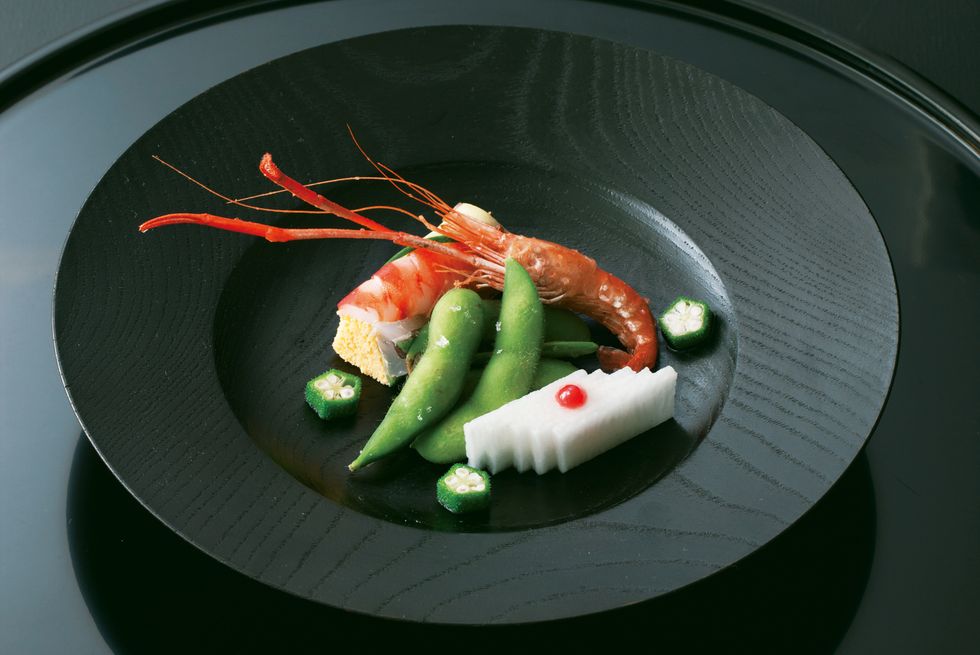
This is the Hassun from Kaizeki cuisine. It consists of small portions of dishes that serve as accompaniments for sake, presented on a single plate with careful attention to color. It can also appear as one of the appetizers in the meal and the specific order may vary depending on each restaurant.
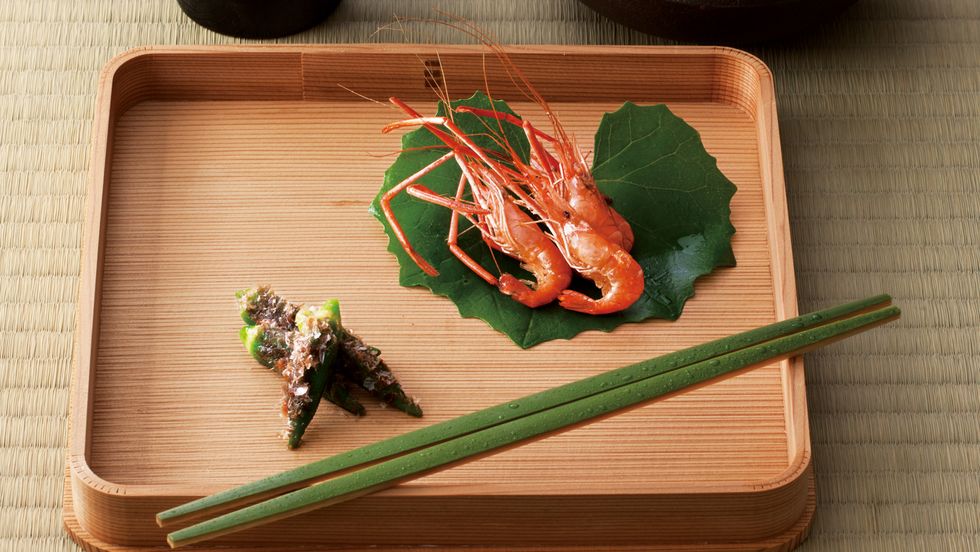
The Hassun from Kaiseki cuisine features elegantly arranged dishes. It includes deep-fried handama shrimp as a representation of the sea and okura (okra) with powdered sansho pepper as a representation of the mountains.
The Hassun in Kaiseki cuisine serves as a companion for sake. It is called "Hassun" because it is served in a square (about 24 centimeters) cedar dish. It follows the tradition of presenting both ingredients from the sea and the mountains. Enjoying these dishes as accompaniments to sake, served with hot sake, is one of the delights of Kaiseki cuisine.
Grilled dish (焼き物)
In Kaiseki cuisine, the grilled dish involves deboning the fish, while in Kaizeki cuisine, the grilled dish is served with the head intact and enjoyed more extravagantly.
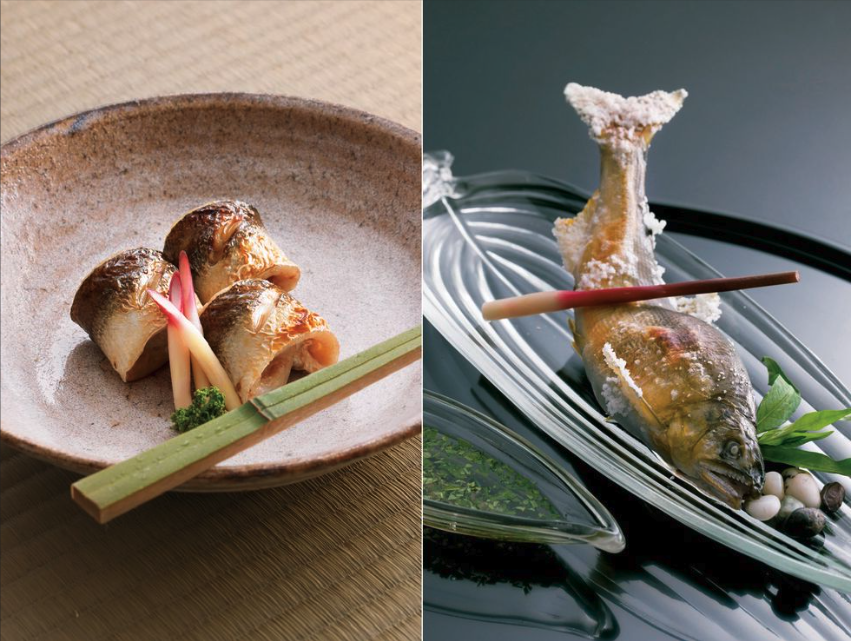
On the left is the grilled dish in Kaiseki cuisine, called "Kamasu no Ryoubi-yaki" (かますの両褄焼き). On the right is the grilled dish in Kaizeki cuisine, called "Wakaayu no Shioyaki" (若鮎の塩焼き).
Both Kaiseki and Kaizeki cuisines feature grilled dishes, often using fish as the main ingredient. In Kaiseki cuisine, the dish is prepared to accommodate the number of guests and is served with bamboo chopsticks for easy handling. On the other hand, in Kaizeki cuisine, a whole fish with the head intact is served, allowing one to thoroughly enjoy it. This is the significant difference between the two. Furthermore, in Kaiseki cuisine, efforts are made to minimize leftovers, so the fish bones are removed. The use of pickled ginger is also more sparing compared to Kaizeki cuisine.
Simmered Dish (煮物/炊き合わせ)
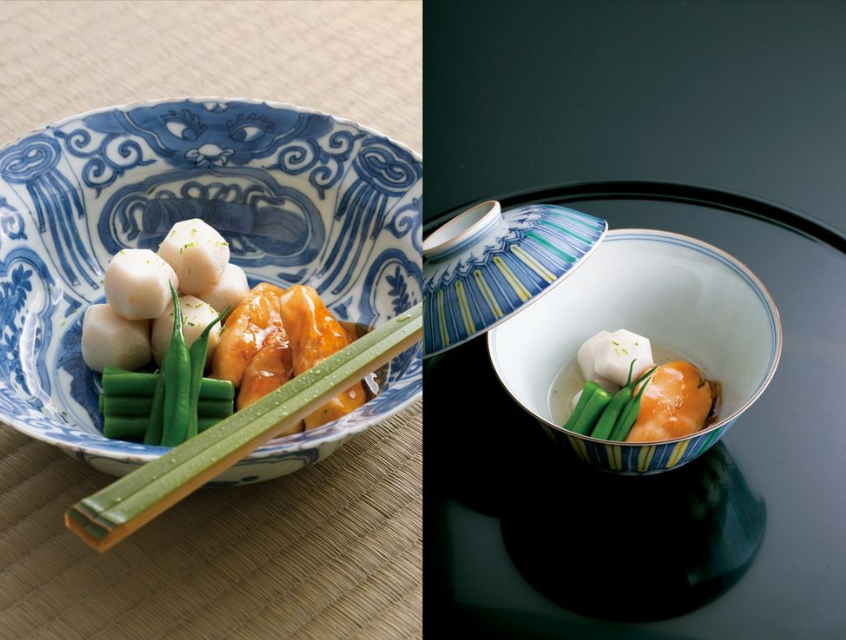
The left is simmered kaiseki cuisine, and the right is simmered kaiseki cuisine. Both dishes are Ishikawa potato and chicken jibuni.
The simmered dish in Kaiseki cuisine, known as "Azukebachi" (預鉢), is similarly prepared in a large bowl, with servings arranged together for convenience. It is characterized by a colorful and three-dimensional presentation. On the other hand, in Kaizeki cuisine, the simmered dish is individually served in covered porcelain bowls or similar vessels. Even though it is the same dish, the choice of vessel and presentation style can create entirely different impressions.
In Kaiseki cuisine, the simmered dish is served after the grilled dish, while in Kaizeki cuisine, it is typically served after the sashimi course.
Rice ご飯
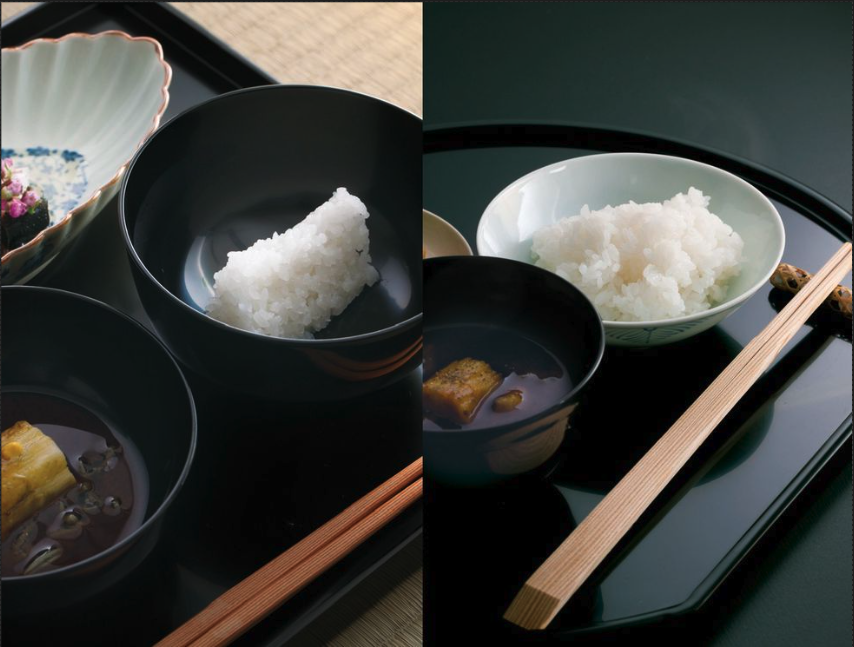
The perfectly cooked rice, checked for its ideal steaminess, is served in a lacquered bowl in Kaiseki cuisine (on the left). And above all, the rice and soup are enjoyed first. In Kaizeki cuisine, to prevent feeling full before drinking sake, the rice and soup are served last (on the right).
In Kaiseki cuisine, rice and soup are the first to be enjoyed. After covering the rice and soup bowls, a red cup placed on a heated saucer is brought out, and the appetizer is enjoyed along with it. On the other hand, in Kaizeki cuisine, to ensure that the guests' stomachs are not too full before drinking sake, rice and soup are served at the end of the meal. In Kaiseki cuisine, the interaction between the host and the guests is essential, and there are many established rules and arrangements for the menu. In contrast, Kaizeki cuisine has fewer set rules, and the menu and order are relatively flexible. Looking back at history, Kaizeki cuisine developed as a banquet cuisine served by the owners of culinary tea houses after haiku and renga poetry gatherings during the Edo period. On the other hand, Kaiseki cuisine spread as the cuisine enjoyed during the tea ceremony, with tea masters and practitioners of the tea ceremony being the main proponents. However, due to the passage of time, even restaurants have started serving dishes in the style of Kaiseki cuisine, such as the Nimonowan (simmered dish in a bowl). As a result, the distinction between the two has become somewhat blurred. That's why it is important to delve into history and understand their origins.
Shojin, Honzen, Kaiseki, Kaizeki
Shojin Ryori
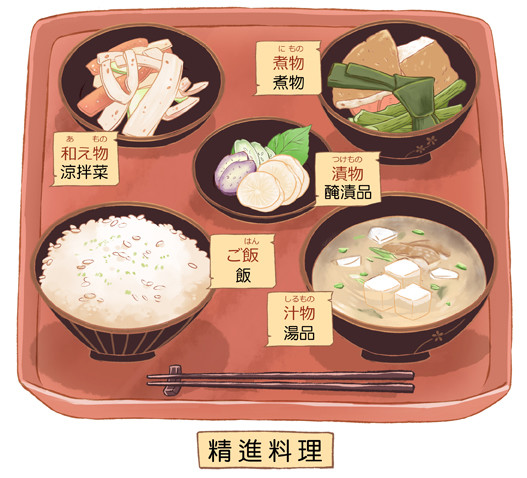
Source:除了好吃之外,你還應該知道的五種日本料理起源和演進
Shojin Ryori is equivalent to vegetarian cuisine. "Shojin" is a Buddhist term that means eliminating worldly desires and devoting oneself to spiritual practice. It is said to have been established by the monks Dogen and Eisai, who studied in China before the Kamakura period. Based on the Buddhist precept of non-killing, Shojin Ryori uses only plant-based ingredients such as vegetables, grains, seaweed, and beans. Initially served to Zen temple monks, it gradually expanded to the general public. To enhance the flavors of the light dishes, various processed foods, seasonings, and cooking methods such as tofu skin, deep-fried tofu, natto, and miso were developed, greatly influencing the future development of Japanese cuisine.
Honzen Ryori
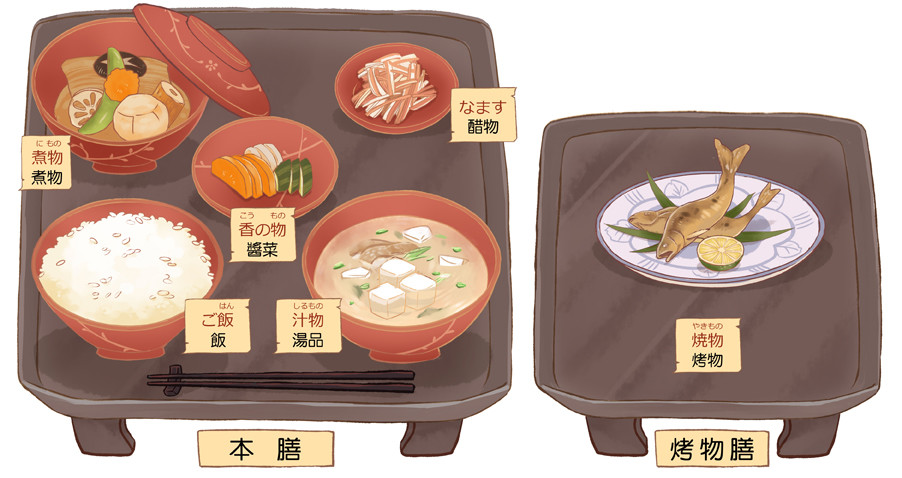
Source:除了好吃之外,你還應該知道的五種日本料理起源和演進
Honzen Ryori originated as ceremonial cuisine among samurai during the Muromachi period and is characterized by its ceremonial nature. It is the most formal form of Japanese cuisine, with strict rules regarding serving and dining order. The eating method of Honzen Ryori involves placing a square table called "zen" in front of guests and serving a basic set of one soup and three dishes. The number of zen and dishes increases based on the scale and occasion of the hospitality, such as two soups and five dishes, three soups and seven dishes, or three soups and fifteen dishes, always in odd numbers, symbolizing auspiciousness. Honzen Ryori gradually declined during the Meiji era and is now only seen on special occasions such as weddings, funerals, coming-of-age ceremonies, and ceremonial events. It has become simplified as Kaiseki Ryori, which is the most common form of banquet cuisine today.
Kaiseki Ryori
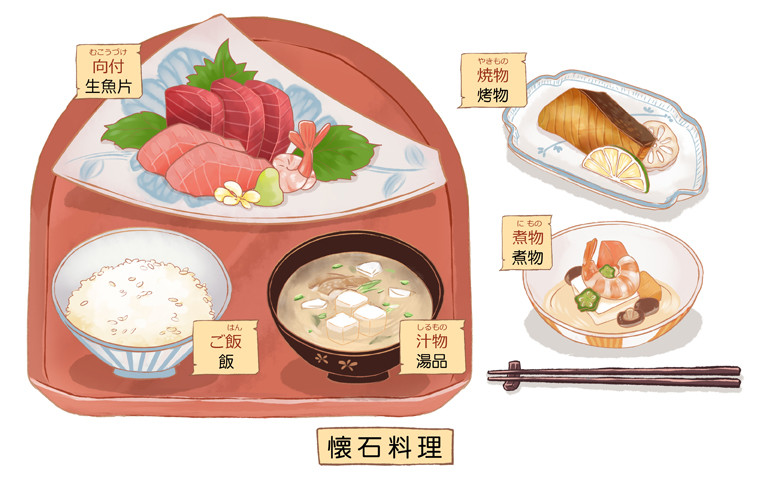
Source: 除了好吃之外,你還應該知道的五種日本料理起源和演進
Kaiseki Ryori originated from the practice of Sen no Rikyu, the founder of the tea ceremony, who created it as a meal to protect the stomach from empty drinking during tea gatherings. "Kaiseki" is said to be derived from Zen monks placing warm stones in their pockets to temporarily alleviate hunger and cold. Traditional Kaiseki Ryori consists of rice, miso soup, sashimi (raw fish slices), wanmono (simmered dishes), and yakimono (grilled dishes), forming a set of one soup and three dishes. Over time, Kaiseki Ryori has become more diverse, incorporating additional elements such as futamono (lidded dish), suimono (clear soup), and hassun (appetizers). Kaiseki Ryori has become synonymous with luxurious cuisine.
【懷石料理的上菜順序】
- ご飯(白飯)、汁(湯)、向付(生魚片)
- 椀物(清湯)
- 焼物(燒烤料理)
- 煮物(燉煮料理)
- 小吸物(小清湯)
- 八寸(動物、植物料理2~3道。盛裝在八寸(24吋)的四方型杉木容器中)
- 湯桶(在熱水中加入鍋巴的一種湯泡飯)・香の物(醬菜)
- 主菓子・濃茶
Kaizeki Ryori
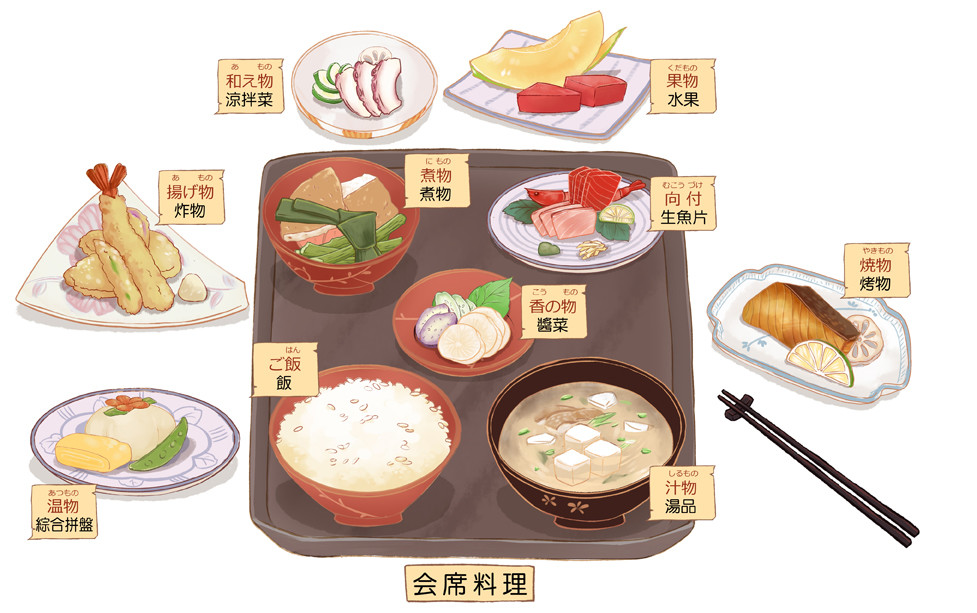 Source: 除了好吃之外,你還應該知道的五種日本料理起源和演進
Source: 除了好吃之外,你還應該知道的五種日本料理起源和演進
Kaizeki Ryori is a cuisine enjoyed by haiku poets after their gatherings and became popular during the Bunka era of the Edo period. Unlike Honzen Ryori, Kaizeki Ryori does not emphasize formalities and allows for a more relaxed and free dining experience, focusing on the enjoyment of delicious food. The dishes in Kaizeki Ryori include zensai (appetizers), wanmono (soup dish), sashimi, hachiya (grilled dish), takiawase (simmered dish), and tsukemono (pickles or salad), accompanied by white rice, miso soup, and pickled vegetables. Some variations may also include deep-fried dishes, steamed dishes, or hot pot dishes, making it more luxurious and abundant.
【會席料理的上菜順序】
- お酒(酒)
- 先付(下酒用的前菜)
- 前菜
- 椀物(清湯)
- 向付(生魚片)
- 煮物(燉煮料理)
- 焼物(燒烤料理)
- 揚げ物(油��炸料理)
- 蒸し物(蒸煮料理)
- 酢の物(醋漬料理)
- ご飯(白飯)・止め椀(味噌湯)・香の物(醬菜)
- 水物(水果、點心)